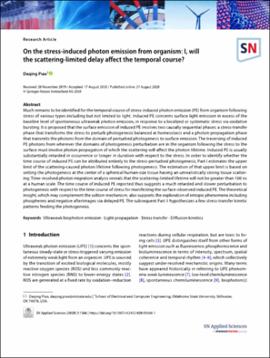| dc.contributor.author | Piao, Daqing | |
| dc.date.accessioned | 2023-07-10T16:34:58Z | |
| dc.date.available | 2023-07-10T16:34:58Z | |
| dc.date.issued | 2020-08-27 | |
| dc.identifier | oksd_piao_on_the_stress_induced_part1_2020 | |
| dc.identifier.citation | Piao, D. (2020). On the stress-induced photon emission from organism: I, will the scattering-limited delay affect the temporal course? SN Applied Sciences, 2(9), pp. 1566. https://doi.org/10.1007/s42452-020-03346-1 | |
| dc.identifier.issn | 2523-3963 | |
| dc.identifier.uri | https://hdl.handle.net/11244/337925 | |
| dc.description.abstract | Much remains to be identified for the temporal course of stress-induced photon emission (PE) from organism following stress of various types including but not limited to light. Induced PE concerns surface light emission in excess of the baseline level of spontaneous ultraweak photon emission, in response to a localized or systematic stress via oxidative bursting. It is proposed that the surface emission of induced PE involves two causally sequential phases: a stress-transfer phase that transforms the stress to perturb photogenesis balanced at homeostasis and a photon-propagation phase that transmits the photons from the domain of perturbed photogenesis to surface emission. The traversing of induced PE photons from wherever the domains of photogenesis perturbation are in the organism following the stress to the surface must involve photon propagation of which the scattering will affect the photon lifetime. Induced PE is usually substantially retarded in occurrence or longer in duration with respect to the stress. In order to identify whether the time course of induced PE can be attributed entirely to the stress-perturbed photogenesis, Part I estimates the upper limit of the scattering-caused photon lifetime following photogenesis. The estimation of that upper limit is based on setting the photogenesis at the center of a spherical human-size tissue having an unrealistically strong tissue scattering. Time-resolved photon migration analysis reveals that the scattering-limited lifetime will not be greater than 100 ns at a human scale. The time course of induced PE reported thus suggests a much retarded and slower perturbation to photogenesis with respect to the time course of stress for manifesting the surface-observed induced PE. The theoretical insight, which may complement the soliton mechanism, also supports the exploration of entopic phenomena including phosphenes and negative afterimages via delayed PE. The subsequent Part II hypothesizes a few stress-transfer kinetic patterns feeding the photogenesis. | |
| dc.format | application/pdf | |
| dc.language | en_US | |
| dc.publisher | Springer Nature | |
| dc.relation.ispartof | SN Applied Sciences, 2 (9) | |
| dc.relation.uri | http://dx.doi.org/10.1007/s42452-020-03346-1 | |
| dc.rights | This material has been previously published. In the Oklahoma State University Library's institutional repository this version is made available through the open access principles and the terms of agreement/consent between the author(s) and the publisher. The permission policy on the use, reproduction or distribution of the material falls under fair use for educational, scholarship, and research purposes. Contact Digital Resources and Discovery Services at lib-dls@okstate.edu or 405-744-9161 for further information. | |
| dc.title | On the stress-induced photon emission from organism: I, will the scattering-limited delay affect the temporal course? | |
| dc.date.updated | 2023-07-02T13:23:31Z | |
| dc.note | open access status: Bronze OA | |
| dc.identifier.doi | 10.1007/s42452-020-03346-1 | |
| dc.description.department | Electrical and Computer Engineering | |
| dc.type.genre | Article | |
| dc.type.material | Text | |
| dc.subject.keywords | engineering | |
| dc.subject.keywords | electrical engineering | |
| dc.subject.keywords | physical sciences | |
| dc.subject.keywords | cardiovascular | |
| dc.identifier.author | ORCID: 0000-0003-0922-6885 (Piao, D) | |
| dc.identifier.author | ScopusID: 7005153312 | 57220465193 (Piao, D) | |
| dc.identifier.author | ResearcherID: I-1341-2013 (Piao, D) | |
| dc.identifier.essn | 2523-3971 | |
